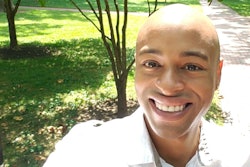Lia Thomas broke records when she raced the 100-meter freestyle at the Ivy League Championships this month. It was just one more record-breaking run for the University of Pennsylvania athlete. But her victory was not met with uproarious congratulations. Instead, headlines and social media posts praised those she left in her wake as the real victors.
The intersection of sexual biology and a level, fair playing field for women in sports is frustrating for Dr. Genny Beemyn, director of The Stonewall Center at the University of Massachusetts, Amherst and coordinator of Campus Pride’s Trans Policy Clearinghouse.
“There are no studies that indicate the higher the testosterone level, the better the athletic performance is,” Beemyn said. “There’s no science behind any of this.”
 Dr. Genny Beemyn, director of The Stonewall Center at the University of Massachusetts, Amherst and coordinator of the Campus Pride’s Trans Policy Clearinghouse.
Dr. Genny Beemyn, director of The Stonewall Center at the University of Massachusetts, Amherst and coordinator of the Campus Pride’s Trans Policy Clearinghouse.
“Brittney Griner [the basketball player] is 6’ 9”—she has a competitive advantage. Michael Phelps has a huge competitive advantage because of the way his body is shaped,” said Beemyn. “No one is saying Griner shouldn’t play because she’s so tall. No one is saying Phelps shouldn’t compete because of his physique. That’s the nature of sports.”
To Beemyn, this renewed attention on Thomas comes as part of a bigger wave of transphobic laws and policies being enacted across the U.S. At the end of February, the Florida House of Representatives passed a bill called “Don’t Say Gay” by its critics, which prohibits the discussion of sexual orientation or gender identity in state primary school. Earlier in the month, South Dakota Gov. Kristi Noem signed SB 46, which prohibits trans youth from playing on school teams that align with their gender identity. On Feb 23, Texas Gov. Greg Abbott said that gender-affirming medical care should be considered child abuse and called on Texans to report parents of transgender youth as criminals.
“To me, it’s so, so odd to hear these folks, who have never been supportive of women’s athletics, all of the sudden be so concerned about it because there are a couple of women, transgender athletes who are doing well,” said Beemyn. “It just shows that this is a convenient excuse to enact their prejudices against trans people, making them disappear.”
Beemyn used their Trans Policy site to track collegiate athletic programs that had trans-inclusive policies. It was a useful site when the National Collegiate Athletic Association’s (NCAA) transgender policies gave more freedom to programs, and in general required transgender athletes to be on hormone treatments for one year before competition. But mid-January, the NCAA changed its policy to mirror that of national and international sport governing bodies.
“I’m very concerned and disappointed by the NCAA’s change,” said Beemyn. “Every sport has a different standard, and I worry about it becoming a competition to see who can impose the most rigid standards to exclude trans women.”
Dr. Jennifer Hoffman, an associate professor of educational foundations, leadership and policy at the University of Washington, said that the exclusion of trans women is just part of the exclusion of women and women-identifying people from sport.
“I think what’s being missed in the dialogue is the ways in which sport is one of the more visible places where we hyper-segregate,” said Hoffman. “Sport is a place where we divide by gender—we start there, then we organize competition.”
Organizing sport by gender makes it difficult to think creatively on ways to accommodate athletes, said Hoffman, including thinking beyond the measure of testosterone as an indicator of athleticism. Beemyn agreed.
“My ideal would be that we eliminate sports based upon gender and base it upon athletic ability. It would certainly help break down the gender binary and recognize that, because people have different bodies and different abilities, or people that are better coached or better trained, they are able to excel in a way that other people aren’t,” said Beemyn.
 Dr. Jennifer Hoffman, associate professor of educational foundations, leadership and policy at the University of Washington.
Dr. Jennifer Hoffman, associate professor of educational foundations, leadership and policy at the University of Washington.
“The numbers of trans people are very small, and trans athletes are small, and the number of those rising to the highest levels are very small,” said Hoffman. Despite their training and years of work, “we don’t accept trans athleticism in the same way of the other members of the pop who rise to higher levels of sport. We’re resistant to include them.”
Joanna Hoffman, director of communications at Athlete Ally, an organization dedicated to ending transphobia and homophobia in sports, said that the NCAA has a responsibility to protect students from harm, just like any institution.
“We are seeing a historic wave of legislation targeting transgender athletes,” said Joanna Hoffman. “We know that transgender athletes’ mental health is being impacted as well,” based on a study done by the Center for American Progress, which indicates that transgender youth are at a greater risk for bullying, threats, and suicide than their cis-gendered counterparts.
To protect their trans athletes, Athlete Ally recommends that institutions engage in proactive education about the lived experiences of trans athletes, and adopt nondiscrimination policies that are inclusive of trans lives. According to Athlete Ally’s Athletic Equity index, institutions have a long way to go, as 92% of Division-1 athletic department do not have fully inclusive trans policies.
Liann Herder can be reached at [email protected].
Editor's Note: A previous version of this article connected Campus Pride and the Trans Policy Clearinghouse with the University of Massachusetts, Amherst. This has been corrected.
















